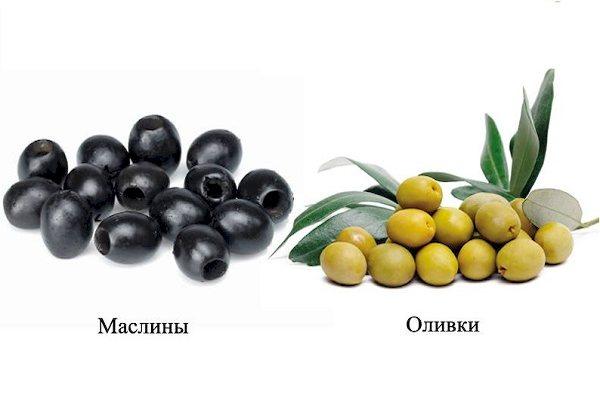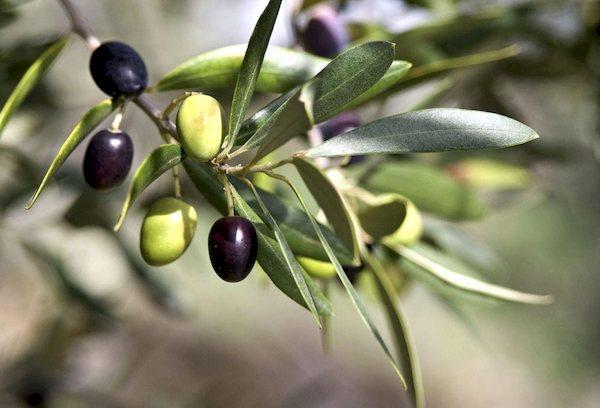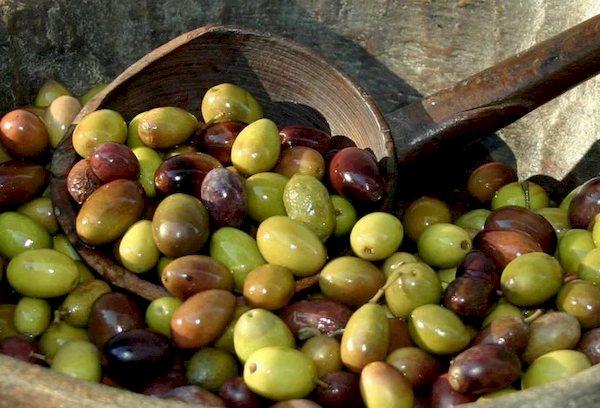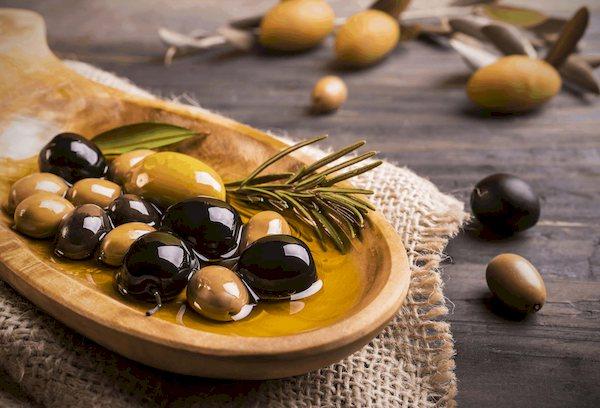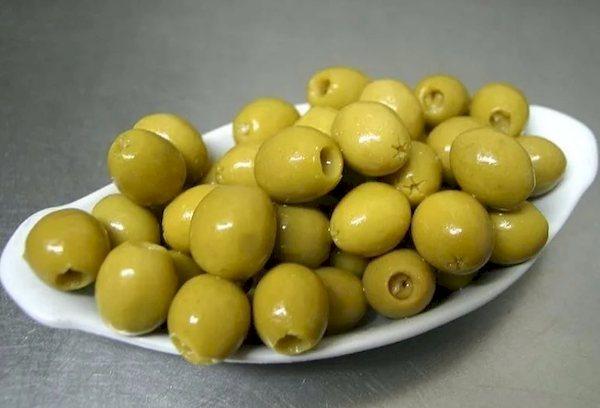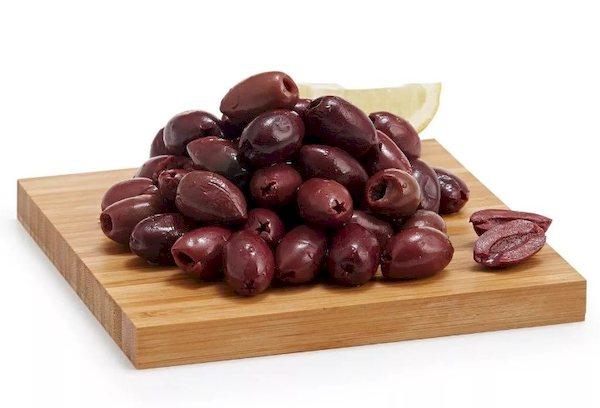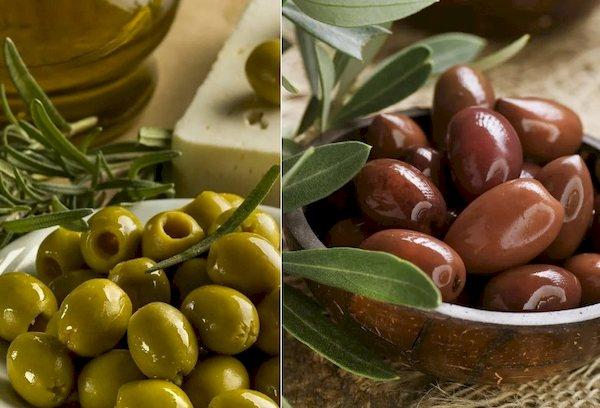What is the difference between olives and black olives?
There are different opinions about how olives differ from olives: degree of ripeness, variety, culinary processing, taste, appearance, benefits for the body. If we consider the olives and black olives sold in Russian stores in jars, there is no significant difference between them. They are prepared from the same unripe fruits of the olive tree. To obtain black olives, green fruits are washed in oxygenated water. To fix the black color, add iron gluconate E579 or other food additives.

You should know that the name “olives” appeared in Russia in the 90s, and is not used in its homeland in Italy and Greece. Italians and Greeks know only “olives” - olive fruits, which are green and black (following the example of green and red tomatoes).
How to distinguish olives from olives?
Olives and olives are different names for the fruits of the olive tree. Nevertheless, in Russia there is an unspoken rule that helps to distinguish one product from another:
Olives are green. There is even such a color - olive. Olives are dark, almost black.
Difference in photo:
How else do olives differ from black olives? Comparison in the table:
| Olives | Olives | |
| Taste | tart, spicy, sourish, fruity | deep, oily, specific, sometimes with a slight bitterness |
| Structure | elastic, dense fruit | soft, “dry” fruit |
| Color | shades of green and yellow | dark purple, black blue, brown |
| Best combination | garlic, lemon, fennel, hot pepper | tomato, cheese, pastries |
| Use in cooking | stuffed olives, martini serve, appetizers, salads | appetizers, olive caviar, pizza, decoration for dishes, salads |
| Price | about 170 rub. for 300 g | about 160 rub. for 300 g |
Olives - what are they?
For Italians, Greeks and all Mediterranean residents, olives are a common food. The olive tree, growing in these parts, symbolizes wealth, prosperity, fertility and peace.
According to ancient Greek mythology, the goddess Athena gave the olive tree to the inhabitants of Greece by plunging a spear into the ground.
Olive is an evergreen tree. The small oblong leaves are dark green above and silvery below. It blooms in May with small, inconspicuous flowers. After a few months, small oval fruits of light green color appear - olives. During this period, the fruits are the densest, most elastic and... very bitter.
Green olives are not eaten fresh. Without special processing they are completely tasteless. The fruits are soaked in soda and salty liquid to neutralize bitter glycosides.
The green fruit stage is where the largest harvest of olives occurs. Only during this period can the bone be extracted smoothly and beautifully. Table varieties, such as Chalkidiki, are prepared for consumption. Often the fruits are pickled with the addition of wild fennel, lemon, garlic, and slices of hot pepper. Green olives are used as a snack, in sauces, salads and many other dishes.
What are olives?
Olive is an oilseed crop. It is grown to produce healthy olive oil. Hence its second name - olive, olive tree (from the word oil).
The olive or olive fruit is left to ripen on the tree and turn dark to produce olive oil.
There are about 70 varieties of olive.Particularly valuable are the varieties from the fruits of which a lot of oil can be obtained - fleshy, with a small core and table fruits, such as Kalamata, Atinoglia, Koroneiki, Tsunati. The fruits of Kalamata, unlike dozens of other varieties, are not picked green, but are allowed to ripen on the tree.
As the green fruits ripen, they acquire a brownish-purple hue and “turn” into olives. Some varieties are allowed not only to ripen, but also to dry (round olives). The bitterness disappears and a pleasant oiliness appears.
Differences in the photo:
Ripe olives are traditionally pickled, stored in olive oil, and sometimes in vinegar. They are very different from the usual olives in jars sold everywhere in Russian stores. Wrinkled and inconspicuous in appearance, “natural” olives are many times brighter in taste and noticeably oily.
Video on the topic:
Question answer
Which is healthier?
Olives sold in jars differ little in chemical composition from green olives. They are prepared from the same raw material, and are equally healthy with a high nutrient content that can be compared to extra virgin olive oil. The fruits contain a sufficient amount of vitamin A, monounsaturated fatty acids, potassium, magnesium, iron, phosphorus, calcium, some vitamins B1, B6, B12, and carotenoids.
If we compare ripe olives and green ones, then dark fruits are definitely healthier. They contain more tocopherols and have a stronger antioxidant effect on the body.
How to distinguish natural olives from colored olives?
The cost of natural olives is many times higher (about 1000-1500 rubles per 1 kg). They are necessarily dried or dried, with a pit, which is very difficult to extract from ripe fruits.The color of natural dark olives is also different - it is heterogeneous, purple-brown.
People have different attitudes towards olives and black olives. For most, this is a holiday appetizer. Non-gourmets do not go into detail about the difference between green and dark fruits, but simply choose olives to taste. They contain valuable fatty acids and other beneficial substances that help keep the skin firm and radiant. The fruits are good for cardiovascular health, good vision and tumor prevention. But do not forget about the impressive amount of salt in the product. It is important not to overuse the “treat”. A dozen olives will satisfy all the body’s needs and allow you to fully enjoy your favorite taste.
